|
|
Development and Prospects of High Strength Pre-stressed Ceramics
BAO Yiwang,SUN Yi,KUANG Fenghua,LI Yueming,WAN Detian
2020 Vol. 35 (4): 399–406
 Abstract
Abstract(
860 )
 HTML
HTML(
55)
 PDF
PDF(6585KB)(
1066
)
It is a worldwide challenge to simultaneously improve the strength and damage tolerance of ceramics, which is a core issue in the development of ceramics and a goal pursued by materials scientists. While the pre-stressed design has been widely used to improve the strength of concrete and glass for over a century, a little progress has been made for ceramic materials. In this paper, the research progresses of ceramic reinforcement are summarized, and a new pre-stressed design and model of high strength and high damage tolerance composite ceramics are proposed. The novel design focuses on the generation of residual compressive stresses on the surface of ceramic components to inhibit crack initiation and growth, and offset the external tensile stress, which can be applied to different fields such as structural ceramics, architectural ceramics, domestic ceramics and so on. This simple and economical technique with no limitation of size and shape in ceramic components has great application prospects.
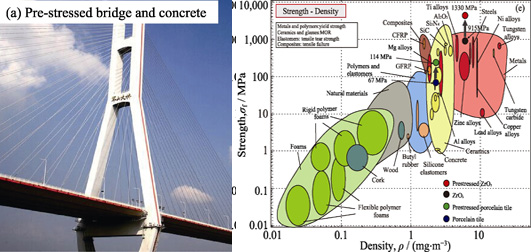
|
|
|
Research Progress on Advanced Carbon Materials as Pt Support for Proton Exchange Membrane Fuel Cells
LUO Yi,FENG Junzong,FENG Jian,JIANG Yonggang,LI Liangjun
2020 Vol. 35 (4): 407–415
 Abstract
Abstract(
1455 )
 HTML
HTML(
82)
 PDF
PDF(13690KB)(
2177
)
Proton Exchange Membrane Fuel Cell (PEMFC) has the characteristics of high energy conversion efficiency, high power density, fast start-up at room temperature, low noise and zero pollution, which is expected to alleviate the energy crisis and reduce carbon dioxide emissions. It has broad application prospects in rail transit, aerospace and other fields. Catalyst is one of the key materials of PEMFC. Moreover, Pt catalysts are widely used and considered difficult to be replaced because of their good activity and stability in oxygen reduction reaction. Pt is expensive because of its limited storage. However, Pt loading could be significantly lessened by Pt support to improve PEMFC utilization. Carbon materials are widely used as Pt supports because of their low cost, high specific surface area, pore structure, adjustable conductivity and surface properties, but commercial carbon black supports have low utilization efficiency and poor electrochemical corrosion resistance for Pt. For realizing the large-scale application of PEMFC, it is necessary to develop new carbon supports which can uniformly disperse Pt, efficiently utilize Pt, be resistant to electrochemical corrosion, and have good conductivity, thus the performance and sustainability of PEMFC are improved. Carbon aerogels, carbon nanotubes, graphene and other new carbon supports with unique structures and properties, which are expected to improve PEMFC performance and life, have attracted the attention of many researchers. In this paper, the research progress on new carbon material as Pt support for PEMFC in recent years is reviewed systematically, and the development trend is also commented appropriately.
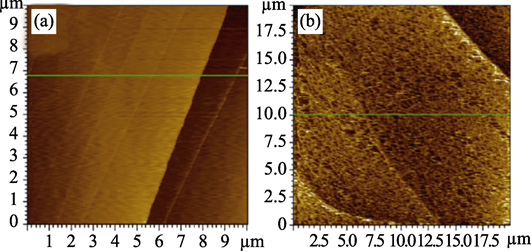
|
|
|
Chip Sensor for pH and Temperature Monitoring Based on ZnO Composite
ZHANG Wei,GAO Peng,HOU Chengyi,LI Yaogang,ZHANG Qinghong,WANG Hongzhi
2020 Vol. 35 (4): 416–422
 Abstract
Abstract(
755 )
 HTML
HTML(
31)
 PDF
PDF(2430KB)(
980
)
Wearable sensors which can evaluate the health status of the human body by conveniently monitoring human’s pH of sweat and body temperature have attracted wide attention. Here, sensors for sweat pH and skin temperature monitoring were developed. ZnO/polyaniline (PAni) micro-nano structure which sensitivity reaches 120 mV/pH realized pH sensing by monitoring the change of surface potential in solutions under different pH conditions. A layer of ZnO/rGO on surface of polyethylene glycol terephthalate/indium tin oxid (PET/ITO) was constructed for temperature monitoring by a simple drop-casting method. With the temperature increasing, the resistance of ZnO/rGO composite decreases, and the sensitivity of its resistance variation reaches -0.67%/℃. Two sensors are integrated into one sensor chip which shows high stability. Therefore, the new sensor with practical and commercial potential is promising in the field of pH and temperature detection.
|
|
|
Preparation of ZnO Nanorods with Lattice Vacancies and Their Application in Ni-Zn Battery
ZHU Zeyang,WEI Jishi,HUANG Jianhang,DONG Xiangyang,ZHANG Peng,XIONG Huanming
2020 Vol. 35 (4): 423–430
 Abstract
Abstract(
693 )
 HTML
HTML(
28)
 PDF
PDF(2348KB)(
956
)
As a type of environmental benign secondary battery with high power density, Ni-Zn battery is often limited by the weakness of negative electrode materials in the applications. In this work, ZnO nanorods (NRs) with high performance were synthesized by Sol-Gel process with hexamethylenetetramine (HMT) as template and subsequent thermal annealing treatment. Morphology, crystalline structure and surface functional groups of ZnO NRs were characterized by transmission electron microscope (TEM), X-ray powder diffraction (XRD) and Fourier-transform infrared spectroscope (FT-IR), respectively. X-ray photoelectron spectroscopy (XPS) and electron paramagnetic resonance (EPR) measurements reveal that ZnO NRs have carbon layers on the surface and vacancies in the lattice. Tafel tests and electrochemical impedance spectroscopy (EIS) show that the corrosion current and charge transfer resistance of ZnO NRs-based electrodes are reduced by 40% and 62%, respectively, compared with commercial ZnO. Further investigation show that Ni-Zn batteries fabricated with ZnO NRs have better cycling performances. After 100 cycles at a current density of 1 A·g-1, the capacity retention rate of ZnO NRs is 92%, which is significantly higher than that of commercial ZnO powder (32%).
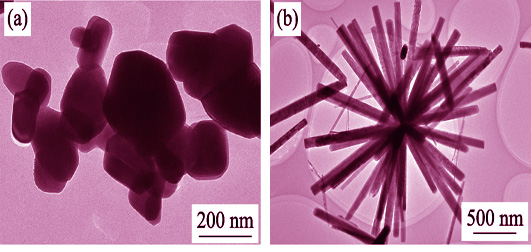
|
|
|
Dielectric and Energy Storage Property of BaTiO3-ZnNb2O6 Ceramics
WANG Tong,WANG Yuanhao,YANG Haibo,GAO Shuya,WANG Fen,LU Yawen
2020 Vol. 35 (4): 431–438
 Abstract
Abstract(
689 )
 HTML
HTML(
21)
 PDF
PDF(1523KB)(
1004
)
(1-x)BaTiO3-xZnNb2O6 (x=0.5mol%, 1mol%, 1.5mol%, 2mol%, 3mol%, 4mol%) (BTZN) ceramics were synthesized by solid state method. The sintering temperature, structure, dielectric property and ferroelectric property of BTZN ceramics were systematically investigated. The sintering temperature of BTZN ceramics decreased with increasing ZnNb2O6 content. XRD results show that the second phase Ba2Ti5O12 was observed when the content of ZnNb2O6 reached 3mol%. The dielectric measurements result showed that with increasing ZnNb2O6 content, the dielectric constant of BTZN ceramics decreased gradually, while the frequency stability of dielectric constant increased gradually. The temperature dependence of dielectric constant results showed that all BTZN ceramics met the characteristics of X8R capacitors. Polarization values of BTZN ceramics decreased with increasing ZnNb2O6 content. The dielectric breakdown strength of 240 kV/cm and a recoverable energy density of 1.22 J/cm 3 were achieved in the sample of x=4mol%.
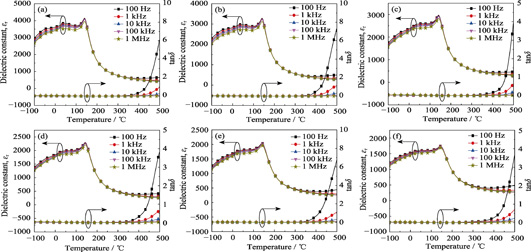
|
|
|
Ionic Liquid Assisted Microwave Synthesis of Cu-In-Zn-S/ZnS Quantum Dots and Their Application in White LED
CHEN Ting, XU Yanqiao, JIANG Weihui, XIE Zhixiang, WANG Lianjun, JIANG Wan
2020 Vol. 35 (4): 439–446
 Abstract
Abstract(
418 )
 HTML
HTML(
6)
 PDF
PDF(7449KB)(
789
)
Cu-In-Zn-S (CIZS) quantum dots (QDs) are considered as promising fluorescent materials owing to their low toxicity, wide emission range and large Stokes shifts, which have a wide prospect in lighting field. CIZS QDs were prepared via ionic liquid assisted microwave method in aqueous solution. The effects of reaction time, addition amount of ligand and pH of precursor solution on phase composition, microscopic morphology and photoluminescence (PL) property were investigated. Results showed that the reaction rate could be accelerated with the assistance of ionic liquid, i.e. the reaction time reducing from 180 min to 30 min. The size of QDs gradually increased with the increase of reaction time, resulting in red shift of emission peak from 609.2 to 634.6 nm. Moreover, the particle size of CIZS QDs increased with the increase of nGSH/n(CuInZn) ratios, resulting in the red shift of emission peak from 622.6 nm to 631.6 nm. Meanwhile, the PL intensity of QDs increased and reached the maximum at nGSH/n(CuInZn)=15. Furthermore, the surface defect state was effectively passivated with the increase of pH of precursor solution due to enhanced bonding force between deprotonized groups (-SH, -NH2) and QDs, resulting in enhancement of PL intensity. And the optimal pH was 8.5. The average hydrodynamic size of CIZS QDs increased from 99 nm to 241 nm with the increase of pH, and the relative Zeta potential ranged from -27.7 mV to -41.1 mV, indicating the excellent stability of CIZS QDs solution. Emission intensity of QDs could be enhanced significantly after coating with ZnS shells. White LED device was fabricated by combining CIZS QDs and a blue chip, the color rendering index and luminous efficiency of device were 85.6 and 34.8 lm/W, respectively, which provided a reference for the application of water soluble multiple QDs in white LEDs.
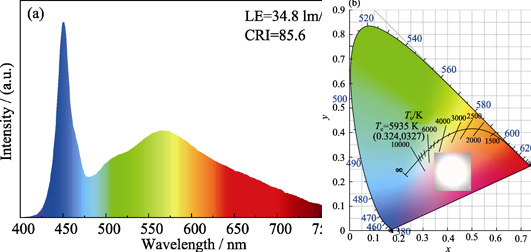
|
|
|
Modulation of Morphology and Luminescence Property of NaBiF4:Yb3+/Er3+ Upconversion Nanoparticles by Organic Ligands
SHAO Kang,WANG Tao,WEN Yingting,TENG Yuanjie,LIU Huijun,PAN Zaifa
2020 Vol. 35 (4): 447–453
 Abstract
Abstract(
608 )
 HTML
HTML(
13)
 PDF
PDF(9313KB)(
835
)
NaBiF4:Yb3+/Er3+ upconversion materials modified by different organic ligands were synthesized by solvent thermal method, and then their morphology and luminescence properties were studied. The results show that the soft template and orientation of the organic ligands can tune the particle size and morphology of the UCNPs, and the defect passivation of the surface organic ligands enhances the luminescence intensity. Especially, the cetyl trimethylammonium bromide (CTAB) and the cetyl trimethylammonium chloride (CTAC) modified materials have the most significant enhancement effect (9 times). Furthermore, the effects of temperature and pH on luminescent properties of the materials were investigated. Results show that, within the range of experimental conditions, the luminescence intensity of the materials decreases with the increase of temperature from 30 to 90 ℃ and significantly reduces under strong acid and alkaline conditions, with maximum at pH 5-6.
|
|
|
Effect of Organic-inorganic Crosslinking Degree on the Mechanical and Thermal Properties of Aerogels
ZHANG Ze,WANG Xiaodong,SHEN Jun
2020 Vol. 35 (4): 454–460
 Abstract
Abstract(
849 )
 HTML
HTML(
13)
 PDF
PDF(1234KB)(
850
)
In all kinds of aerogels, silicon-based aerogel possesses the most comprehensive mechanism of Sol-Gel process and maturest synthesis process. In this work, different types of silicon-based aerogels were prepared via different silicon precursors including tetraethoxysilane (TEOS), methyltrimethoxysilane (MTMS), vinylmethyldimethoxysilane (VMDMS) and the mixed precursor of MTMS and dimethyldimethoxysilane (DMDMS). All samples display high specific surface area and porous microstructure. Effect of the precursor structure on the mechanical and thermal properties of final samples was deeply investigated. The results show that elastic property of silicon-based aerogels depends greatly on the crosslinking degree of their skeleton. The lower the crosslinking degree of the sample is, the better the elastic property is. Furthermore, the elastic property can be further improved by introducing hydrocarbon chains into the skeleton. Thermal conductivity of the obtained aerogels is between 0.032 and 0.041 W/(m·K) at room temperature. Their weight loss increases with the increase of the organic component in the skeleton. Superior mechanical and thermal properties enable silicon-based aerogels to be promising candidates for thermal insulation and energy storage.
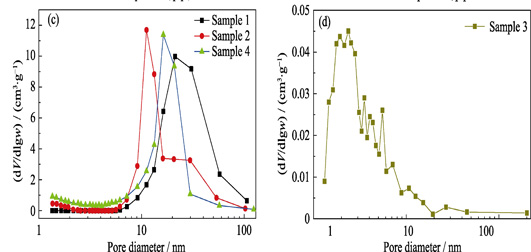
|
|
|
Long-term in Vitro Corrosion Behavior of Zinc in Ringer’s Solution
TANG Shuai,ZHANG Wentai,QIAN Junyu,XIAN Peng,MO Xiaoshan,HUANG Nan,WAN Guojiang
2020 Vol. 35 (4): 461–468
 Abstract
Abstract(
468 )
 HTML
HTML(
10)
 PDF
PDF(4582KB)(
771
)
In recent years, zinc-based biodegradable materials have gained significant attention due to their desirable biodegradation rate compared with other extensively explored biodegradable metals, such as magnesium and iron. However, the long-term corrosion behavior of zinc in simulated body fluid remain unclear. In this study, we performed a 56 d immersion test to reveal the long-term evolution of corrosion behavior of zinc in Ringer’s solution using electrochemical methods and surface analysis. The results showed that the corrosion rate of Zn calculated from current density ranged from 0.06 to 0.1 mm/a during the immersion. Its corrosion rate, determined by weight loss method, was from 0.3 mm/a to 0.5 mm/a. The corrosion products were mainly composed of Zn5(CO3)2(OH)6 and CaCO3. These products were firm, rod- and block-like formed on Zn surface, and gradually accumulated with increase of immersion time. Its surface morphology after removing corrosion products exhibited increasing sizes of corrosion pits and grooves with increase of immersion time. And width of the corrosion pits and grooves was about 10 μm after 42 d immersion. This study provides a guideline for the further surface modification and biomedical applications of Zn-based materials in terms of biodegradation profile.
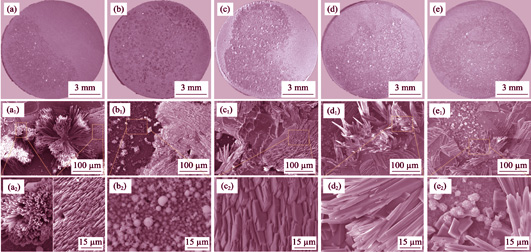
|
|
|
Theoretical Investigation on Adsorption and Separation of CO2/N2 in Hybrid Ultramicroporous Materials
LU Xiaoqing,WANG Maohuai
2020 Vol. 35 (4): 469–474
 Abstract
Abstract(
727 )
 HTML
HTML(
22)
 PDF
PDF(1272KB)(
826
)
Carbon capture and storage (CCS) is a promising strategy for reduction of CO2 emissions. Herein, CO2/N2 adsorption and separation in three SIFSIX-X-Cu (arrayed via SiF6 2- with Cu metal center, X = 2, 3, O) hybrid ultramicroporous materials at 298 K within 0-5 kPa were investigated by using grand canonical Monte Carlo (GCMC) simulation. Results showed that, in contrast to SIFSIX-2-Cu, CO2 adsorption in SIFSIX-3-Cu and SIFSIX-O-Cu reached saturation at 0.5 kPa and their CO2 adsorption capacity were 2.70 and 2.39 mmol·g -1 at 1 kPa, respectively. The CO2 adsorption capacity in CO2/N2 mixture barely decreased. SIFSIX-3-Cu and SIFSIX-O-Cu owned close pore sizes to CO2 dynamics diameter, thereby exhibiting high CO2 affinity with adsorption heat of 59 and 66 kJ·mol -1, respectively. Density functional theory (DFT) analyses showed only one CO2 molecule could be adsorbed in each hole and located at the center of SIFSIX-3-Cu and SIFSIX-O-Cu. Our results provide a theoretical guidance for developing ultramicroporous materials in adsorption and separation of CO2 at low pressure.
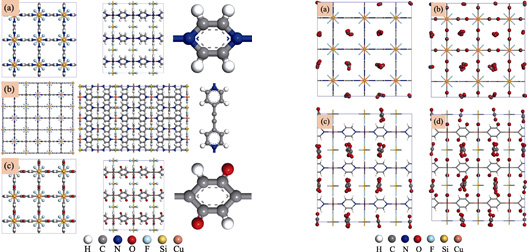
|
|
|
Preparation of Superhydrophobic Composites Sponge and Its Application in Oil-water Separation
ZHANG Ying,ZHANG Qian,ZHANG Ruiyang,LIU Shuaizhuo,Fan Leiyi,ZHOU Ying
2020 Vol. 35 (4): 475–481
 Abstract
Abstract(
985 )
 HTML
HTML(
56)
 PDF
PDF(3492KB)(
1032
)
The treatment of oily wastewater has become a worldwide problem. How to effectively separate the oil-water mixture has become an urgent problem to be solved. Here, the environmental friendly and simple dipping surface modification method was used to modify the melamine sponge (MS) by using a mixture of graphene oxide (GO) and polytetrafluoroethylene (PTFE), and superhydrophobic material (GPMS) was successfully prepared. Structure, morphology and composition of the obtained GPMS were analyzed by X-ray diffraction (XRD), thermogravimetric (TG), Fourier transform infrared spectroscope (FT-IR), and scanning electron microscope (SEM). Its surface wettability, compression cycle, selective adsorption performance, and continuous oil-water emulsion separation performance were systematically studied. The results show that the GPMS is superhydrophobic with hydrophobic angle up to 168°. It can undertake 50 compression cycles, selectively adsorb both floating oil and underwater heavy oil, and efficiently separate oil-water emulsion. Therefore, the GPMS is a kind of potentially applicative oil pollution control material.
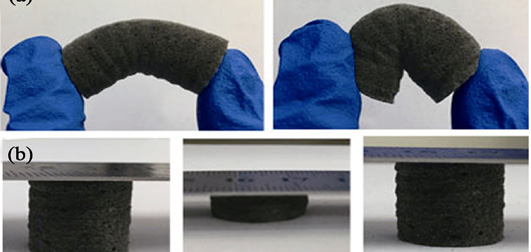
|
|
|
Removal of Volatile Organic Compounds Driven by Platinum Supported on Amorphous Phosphated Titanium Oxide
HUANG Xieyi,WANG Peng,YIN Guoheng,ZHANG Shaoning,ZHAO Wei,WANG Dong,BI Qingyuan,HUANG Fuqiang
2020 Vol. 35 (4): 482–490
 Abstract
Abstract(
637 )
 HTML
HTML(
13)
 PDF
PDF(2505KB)(
747
)
Development of high efficiency catalyst is the key factor to catalytic combustion of volatile organic compounds (VOCs). Herein, amorphous mesoporous phosphated TiO2 (ATO-P) with high specific surface area supported platinum catalyst was successfully fabricated. P-dopant can increase the surface area (up to 278.9 m2·g-1) of ATO-P, which is 21 times higher than that of pristine TiO2, and make the amorphous titanium oxide structure. The supported Pt catalyst with amorphous mesoporous feature shows impressive performance and excellent thermostability for VOCs oxidation. The Pt/ATO-P catalyst exhibits outstanding catalytic efficiency, the T50 and T90 (temperatures required for achieving conversions of 50% and 90%) are respectively 130 ℃ and 140 ℃, for toluene oxidation under high gas hourly space velocity (GHSV) of 36000 mL·h-1·g-1 and toluene concentration of 10000 mL·m-3. The performance is superior to the reference Pt/TiO2 and comparable with the state-of-the-art catalysts. These findings can make a significant contribution on the new applications of amorphous mesoporous phosphated materials in VOCs removal.
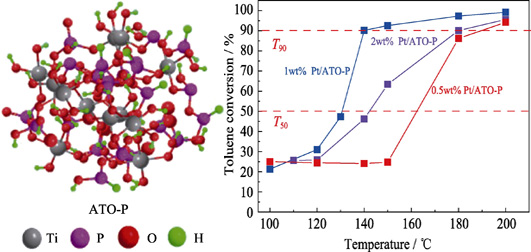
|
|
|
High Efficient Carbon Quantum Dots/BiOCl Nanocomposite for Photocatalytic Pollutant Degradation
ZHANG Zhijie,HUANG Hairui,CHENG Kun,GUO Shaoke
2020 Vol. 35 (4): 491–496
 Abstract
Abstract(
827 )
 HTML
HTML(
28)
 PDF
PDF(873KB)(
1011
)
To overcome the limitation of narrow photo-absorption range and high electron-hole recombination rate of pure BiOCl, a nanocomposite of carbon quantum dots (CQDs) and BiOCl with highly efficient photocatalytic activity was fabricated. The photocatalytic decomposition of rhodamine B (RhB) showed that the CQDs/BiOCl nanocomposite displayed superior photocatalytic performance to pure BiOCl, which was about 3.4 times higher than that of the latter. The optimal loading amount of CQDs was 7.1wt%, which could completely decolorize RhB within a short period of only 2 min, while the degradation rate of RhB was only 29.5% by pure BiOCl in the same period. UV-Vis diffuse reflectance spectra (UV-Vis DRS), photoelectrochemical measurement, and radicals trapping experiments were performed to elucidate the possible mechanism for the enhanced photocatalytic activity of the CQDs/BiOCl composite. The results show that CQD can expand the visible light absorption range of BiOCl, which is beneficial for light harvesting and generation of electron-hole pairs. Moreover, CQDs has unique up-converted photoluminescence behavior, as well as photo-induced electron transfer ability, which leads to enhanced photocatalytic performance of the CQDs/BiOCl composite.
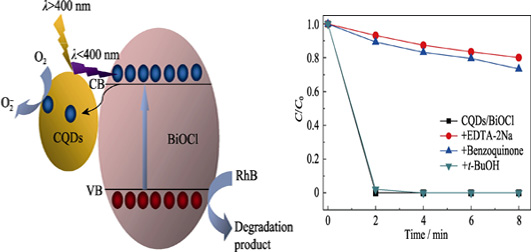
|
|
|
SnS2 Nanoplates: Synthesis and NO2 Sensing Property
SHAN Wei,FU Zhengqian,ZHANG Faqiang,MA Mingsheng,LIU Zhifu,LI Yongxiang
2020 Vol. 35 (4): 497–504
 Abstract
Abstract(
591 )
 HTML
HTML(
9)
 PDF
PDF(13947KB)(
1024
)
Two-dimensional (2D) metal sulfide materials are ideal for use in gas sensing applications due to their low electronic noise and a large specific surface area, and the research on highly efficient and morphologically controllable methods for preparing two-dimensional metal sulfide materials is necessary. Highly crystalline 2D hexagonal SnS2 nanoplates (NPs) with different morphologies were prepared by high temperature chemical bath method. SnS2 NPs were characterized by different techniques, and their gas sensing properties were further investigated. The results show that when the molar ratio of oleic acid (OAc) to oleylamine (OAm) is 1 : 1, the shape of typical SnS2 NPs is a uniform hexagon, with a diameter of about 150 nm and a thickness of 4-6 nm. The gas sensing test shows typical SnS2 NPs are responsive to NO2 gas, and the sensing process is reversible and selective. The optimal operating temperature is 130 ℃, and the response and recovery time are 98 and 680 s, respectively.
|
|
|
Synthesis, Crystal Structure, and Electrical Conductivity of Pd-intercalated NbSe2
HUANG Chong,ZHAO Wei,WANG Dong,BU Kejun,WANG Sishun,HUANG Fuqiang
2020 Vol. 35 (4): 505–510
 Abstract
Abstract(
739 )
 HTML
HTML(
14)
 PDF
PDF(1264KB)(
822
)
New intercalated compounds PdxNbSe2 (x=0-0.17) were synthesized via solid-state reaction. They possess the parent structure of 2H-NbSe2 and crystalize in the hexagonal space group of P63/mmc. The intercalated Pd occupies the octahedral position in the van der Waals gaps of 2H-NbSe2. Unit cell parameter c increases linearly with the Pd content, while a is nearly unchanged. The lattice parameter of Pd0.17NbSe2 (a=b=0.34611(2) nm, c= 1.27004(11) nm) is identified by single crystal X-ray diffraction. The intercalated Pd stabilizes the crystal structure of NbSe2 by connecting the adjacent Nb-Se layers with [PdSe6] octahedra and leads to the enhanced thermostability in air. Temperature dependence of electric resistivity reveals that the residual resistivity ratio of PdxNbSe2 monotonically decreases with addition of the intercalated Pd content. The decreased superconducting critical temperature of PdxNbSe2 indicates the suppression effect of Pd intercalation on the superconductivity in the host NbSe2.
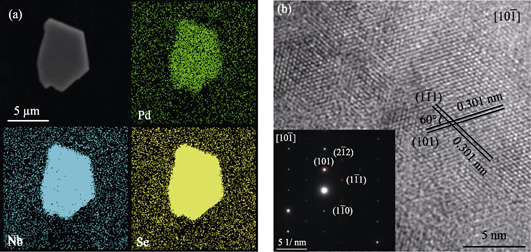
|
|